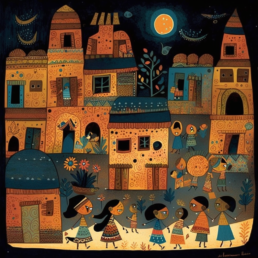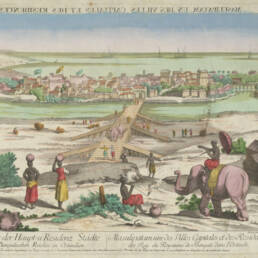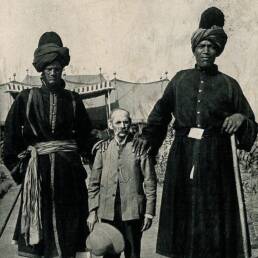Kings in Exile
The longing for a homeland
What do the Last Mughal Emperor and the Last Burmese sovereign have in common? They remain in perpetual Exile. As we revisit a troubled past their tales and fates come across as not very dissimilar from each other. This is but a small snippet, a window into their last days spent away from their beloved homeland
By Aratrika Ganguly
The invaders were at the door, to claim a very precious price.
Mandalay appeared like a ghost town, it’s beautiful streets were lined up with large columns of British troops. People were afraid to venture out. Inside the Golden palace the affairs were more chaotic, people were crying, running and some trying to salvage or take away whatever they could. Thibaw was only 26 at the time when Her Majesty’s men came knocking.
Sitting on the lion throne he would implore his captor Colonel Sladen ‘If i cannot live in the palace give me a little house in Mandalay’ [2]
The decision however was already made for Thibaw, he was to be permanently deported to India, never to see his beloved Swarnabhumi (The Golden Land) again.
While standing on the shores of the beautiful Arabian Sea, I could feel the breeze of history enveloping my tired and sad mind. My visit as a Fellow working in the University of Calcutta to Ratnagiri for field work concerning the last king of Myanmar was during a very low point in my life. The visit however would fill my mind with the wonder of history and one of intrigue.
A small settlement on the fringes of the western coast of India, Ratnagiri would have come to life when Thibaw and his royal entourage walked into it. Odd looking faces with strange attires however must have made Thibaw and his family feel a little out of place and almost alien like in a very foreign land, but he was deprived of a choice.
Ratanagiri was supposed to be where he, the last scion of Konbaung Dynasty of Burma (Myanmar) would spend the rest of his days.
Scenes like these however were not new to the subcontinent back then. Months before Thibaw was born some fifteen hundred miles away in Dilli in the corridors of the Red Fort a trial was being held. The accused was a former king, being prosecuted for leading an uprising to overthrow the powerful East India company. It was more of a victor’s trial then an actual legal proceeding as the king was not a british subject. But as was the case with Thibaw the vanquished very rarely have their say. The king was found guilty and sentenced to exile never to see his beloved Dilli again, place of his exile was to be Rangoon.
Days after the trial the HMS Magara docked at the port of Rangoon. There was a considerable amount of crowd, swelling with anticipation to get a glimpse of the passengers on board.
There was constant whispering and gossiping but none of the onlookers could make out who the old frail man was who had just de-boarded the ship. Lt. Edward Ommaney, the man in charge of the company led the frail man and whatever remained of his family through the docks to where they were temporarily being set up. But the setup was not worthy of any comfort to a former king and his family. Ommaney would report this to his superiors.
“The Prisoners now have scarcely any comfort. The Government is bound to treat them better” – Ommaney in his letter to his superior. [1]
Days later, feeling homesick, Ommaney would take leave and the prisoners would move to their new accommodation where they would be keenly watched upon by their new warden Capt. Nelson Davies. The old man, fondly called by his pen name Zafar(born as Mirza Abu Zafar Siraj-ud-din Muhammad), didn’t know how far exactly he was from his home, his Dilli.
Compared to his Dilli, where he was once a king, a calligrapher, a renowned poet, a descendent of a powerful dynasty, the last of the Mughals, Rangoon felt strikingly unfamiliar. The architecture, its houses and palaces with its beautiful wooden work, its monasteries and pagodas gilded in gold, the odd smell of its food, Zafar must have felt out of place. Thibaw would have the same feeling many years later.
Their fates intertwined in such a queer manner.
Once emperors of the richest and most diverse kingdoms in the world were reduced to paupers in exile by their colonial masters. Powers and privileges snatched away from them, swiftly like the breeze that sweeps away the paddy fields during a monsoon rain
Kitna hai badnaseeb Zafar dafn ke liye
Do gaz zameen bhi na mili ku-e-yaar mein
(How unfortunate is Zafar that for burial, not even 2 yards were spared in the land of the beloved –a poem often attributed to Zafar.)
While visiting the Thibaw Palace in Ratnagiri, the house where Thibaw spent his last few years in Ratnagiri, I could feel Thibaw singing Zafar’s laments in his own language.
I found some local boys playing on the fields of Ambedkar Wadi (a locality in Ratnagiri) beside the Outram House, where Thibaw and his family spent the maximum years in Ratnagiri before shifting to the Thibaw Palace. They told me how the king would pray in the Buddhist Vihara situated beside house, how he would stand near the sea and look longingly at the distant horizon waiting for ships to come from his beloved Burma. These stories were passed onto them by their fathers or grandfathers who would have seen the king in flesh.
The ships never came however; rather every uprising by the people still loyal to the exiled king were curbed mercilessly by the British.
Much of their wealth was left behind in Burma. It is said to secure their future the king even had to part ways with the Nga Mauk, the ‘ruby among rubies’ and not even the king’s private treasury was spared. Most of the items were looted in the nights concluding to the deportation, the rest taken away by the British army. The Royal family was permitted to carry very little of whatever was left of their vast riches. Their lives in Ambedkar Wadi was a very ordinary one.
Zafar’s fate was not so different; he and his family were allowed to take very little of their vast treasures during their travels. However while the colonial government was somewhat sympathetic towards Thibaw, towards Zafar, they showed indifference. It was always a fear that Zafar’s name and lineage was still powerful enough to conjure up yet another uprising. The family was keenly watched upon, every step minutely examined. Their accommodation which was half a mile away from the Shwe Dagon Pagoda was two storeyed and consisted of 4 rooms and it was nothing like the extravagant Zafar Mahal or the elegant palaces inside the Lal Qilla.
Zafar and his sons would often sit on the verandah on the 2nd floor and would be found idly chatting with each other or watching the commotion below, trying to taste some semblance of normalcy. They were not allowed to interact with anybody without prior permission, pen and paper were strictly prohibited. Zafar, whose poems once lit up the mushairas of Dilli, had to scribble his poetry on the walls of his room with a burned stick during his last days. Even their warden Capt. Davies while writing letters to his superiors was barred from using words like “ex-King” or the “ex-Royal Family”.
Zafar and Thibaw were not extremely popular kings, they were often seen as weak and timid and prone to ill advice. The muslim population of Rangoon almost knew nothing of Zafar during his exile there as they were kept in almost isolation. For Thibaw on the other hand people from the budhhist community and indeed in general knew about the late King only because of the existence of the Thibaw palace which was built around 1910 and had no added affinity towards the burmese scion.
The palace was built after many petitions by Thibaw to have a house suitable for a royal family. The late king had given a substantial amount of his input into the new palace’s construction, from the amount of Burmese teakwood that emerges from its staircases and doors, to the mangalore tiles that sits on its roof. Though it was nothing compared to the magnificence of the Golden Palace it was a place where Thibaw would feel close to home. The palace looks imposing even today sadly though only a handful of items belonging to the late king are left now.
When I met Nana Guruji, an elderly gentleman living in the locality near the palace, he spoke about how the only interaction Thibaw had with the locals was by employing them at his service. Thibaw never really did like Ratnagiri nor its people that much. Things got a little out of hand when his eldest daughter, Phaya Gyi, got involved with the Palace’s gatekeeper, a local Marathi man called Gopal Bhaurao Sawant. They never got married but that act would forever make the First Princess an outcast within her own family. Among the other three daughters of Thibaw, the second one settled in Kalimpong in North Bengal. The other two siblings left India and settled in Myanmar after Thibaw’s death.
Phaya Gyi’s family is still there in Ratnagiri who welcomed my visit with warmth and joy. With every passing generation they have integrated more and more with the local Marathi population. The Powar family is descended from Phaya Gyi’s daughter, Tutu. When I visited them for the first time, they showed me their family album and the first picture was of Thibaw and his chief consort, Supalayat. Some of the stories they told me of Thibaw and Tutu, his grandchild were fascinating to say the least. Conditions were so bad once for Tutu after Phaya Gyi’s death that she used to do odd jobs to earn some money.
Talking to them, hearing their tales, their strong zeal (almost a hopeless dream) of getting back the Thibaw Palace from the government of India. One could get a fleeting sense of their royal heritage and their desire to have at least some portion of it restored.
Nothing much is left of Zafar’s lineage sadly. Of his two sons it was Mirza Shah Abbas who had the more simpler tastes and probably that’s why he was able to escape some of the misery that was thought to have cursed his family. He married the daughter of a local Mohamadden merchant and lived a very elementary life. Jawan Bhukt Zafar’s elder son on the other hand drowned himself in drinking. While his wife who after her father in law’s death was slowly losing her sight was driven to the ground, situations were suich dire that she had to give up her ornaments to obtain food for her children.
Zeenat Mahal, Zafar’s favorite queen outlived him by almost 20 years but her life was no less miserable for it. Not able to return to her homeland and dominated by her son Jawan Bhakt, she used to frequently ramble about how she lost her private treasures and jewels during the mutiny (which she never supported from the onset). Even though Maj. Hodson pledged his word to give them back, he never did. She died heartbroken and was unceremoniously buried beside her husband.
Thibaw’s chief consort was given permission to go back to Burma while his junior queen met an untimely death. Today Supayagalae (junior queen) rests along with Thibaw on a small hilltop not far away from the Thibaw palace. A man who was working at the Palace took me to see their graves.
Away from the hustle of the town, the resting place of Burma’s last king is surrounded by tranquillity and peace.
Apparently, the graves were restored when Thibaw’s descendants from Myanmar visited Ratnagiri in 2016 marking Thibaw’s hundredth death anniversary.
Zafar’s death on the other hand was hushed up by the british and for a time the location of his grave was even forgotten. It took the colonial government almost half a century after Zafar’s death to consider a proper gravestone on his tomb.
These days it’s a shrine, a Dargah which is not only visited by wandering travellers who consider Zafar as a Sufi Saint but also by powerful politicians and dignitaries from all around the world seeking his blessings.
The dead kings remain in exile still, their pain and neglect although not forgotten has drowned in the echoes of time. Their life in exile reminds us of the ravages of a colonial past, of betrayal, of persecution, of a weak monarchy. In death however, both the kings have created an invisible bond between the two nations which has drawn people like me towards it like gravity and which will constantly be revisited and studied upon.
ACKNOWLEDGEMENT:
I would like to give my heartfelt thanks to Dr. Mrinmoy Pramanick, Asst. Prof in the Dept. of Comparative Indian Language and Literature, University of Calcutta and the UGC UPE II Project conducted by him for giving me the opportunity to interview Thibaw’s descendants while working as a Project Fellow on behalf of the university.
REFERENCES:
- Dalrymple, William. 2014. The Last Mughal. London: Bloomsbury Publishing.
- Sudha Shah. 2014. King in Exile. Harpercollins India.








